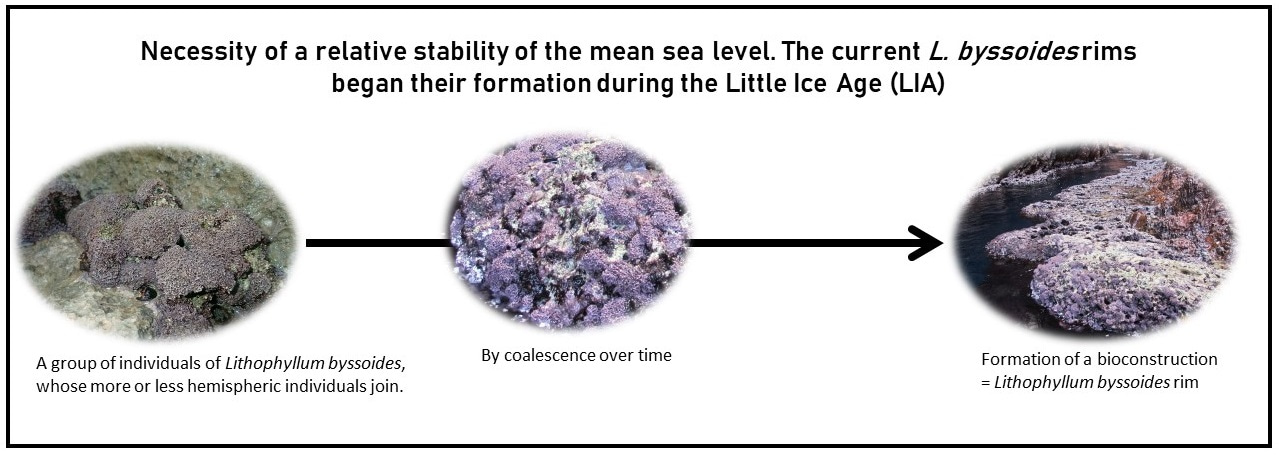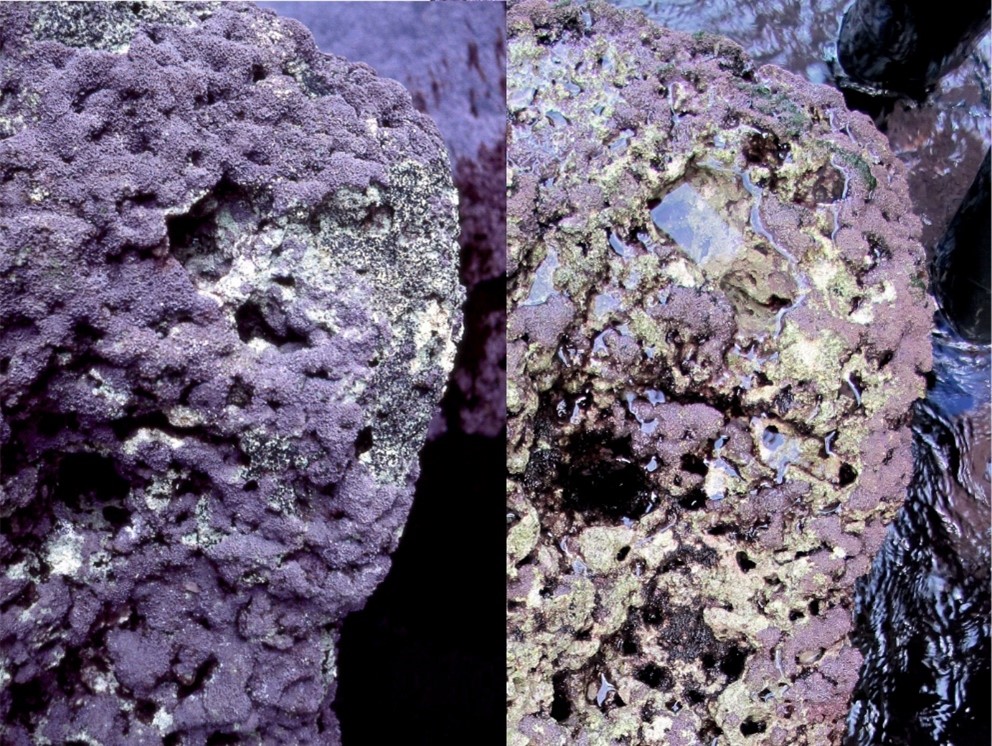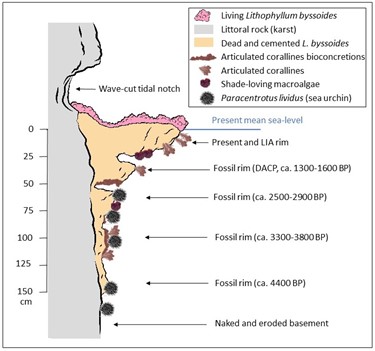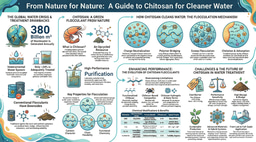Sea level rise in the Mediterranean Sea, a first victim
Published in Ecology & Evolution
The increase in sea level is inexorable and varies in magnitude in different coastal areas of the Earth since the beginning of the Anthropocene. In the Mediterranean, sea level has already risen by 16 cm in 100 years. Although this increase may seem modest, it is already impacting one of the most emblematic habitats of the Mediterranean: the rims of the calcareous red alga Lithophyllum byssoides. The name Lithophyllum comes from the Greek words Litho, meaning stone, and phyllum, meaning leaves, referring to its calcareous envelope that gives it a stone-like hardness.
This habitat is unique because it only forms at the interface between the sea and the land, marking the beginning of the intertidal zone in the Mediterranean. The tidal range in this region is very small, about fourty centimeters on average, except for three areas where it is more significant. The overhangs are formed by the accumulation of individuals on top of each other, with only the top few millimeters remaining alive (Figure 1). To form this bioconstructed habitat, stability in sea level is necessary for centuries. The structures we currently observe were formed during the Little Ice Age, from the 13th to the mid-19th century. The most spectacular rims can reach up to 2 meters in width and several tens or even hundreds of meters in length. In the Mediterranean, this is a three-dimensional habitat that supports significant species diversity and functionality. However, the study of the impact of sea level rise is still underdeveloped in the Mediterranean. In a large-scale study conducted along the French Mediterranean coast in Provence and Corsica, we demonstrated that most overhangs were strongly impacted by rising sea levels. These studies were conducted in both human-impacted areas and marine protected areas.

Figure 1. Formation of Lithophyllum byssoides rim over time
Since the 1980s, the condition of L. byssoides bioconstructions has significantly deteriorated. These bioconstructions have experienced reduced coverage of living L. byssoides individuals, invasion by infralittoral algae, and bioerosion, resulting in the formation of progressively enlarging holes, resulting in the collapse of the rim (Figure 2).

Figure 2. Comparison of the top of the Lithophyllum byssiodes rim called rim of Cala Litizia (Scandola, Corse) over time. In right an almost healthy sidewalk in 1995 and in left an unhealthy sidewalk (rim eaten away by erosion) in 2014
The suitable vertical range for this species is limited to approximately 20 cm. It cannot grow much higher due to insufficient wetting, nor can it extend too far downward due to excessive wetting. Consequently, its growth primarily occurs horizontally, towards the open sea, with living individuals settling on top of deceased ones. This process leads to the formation of a rim composed of Lithophyllum byssoides. The activity of bio-eroders is positively enhanced by wetting, as evidenced by the relatively rapid (centuries or millennia) disappearance of fossil rims, when they became submerged, due to the sea level rise (Figure 3).

The deterioration of these rims is widespread, indicating that it cannot be solely attributed to local stressors. It is possible that different populations of L. byssoides in various geographic areas may respond differently to climate-related changes, and some populations may be more resilient than others. However, the main and inevitable threat to these rims is the global rise in sea level. Sea level rise, although a slow and long-term process seems to have reached a tipping point. Unlike other stressors, the rise in sea level cannot be addressed through local management measures.
Fluctuations in sea levels have occurred throughout Earth's history, but it is the first time that we can observe such rapid degradation of a heritage habitat like the Lithophyllum rims in the Mediterranean. While the fate of these habitats seems sealed, even the most optimistic projections for sea level rise in the Mediterranean estimate an increase of 80 cm by 2100. This raises the question of which coastal habitats will be threatened next, such as slow-growing marine forests. Perhaps the submersion of Lithophyllum rims will serve as a wake-up call for the inhabitants of the Mediterranean, highlighting the profound changes they will have to face in their lifetimes.
For more details, we invite you to read our publication (Following this link: DOI: 10.1038/s41598-023-37110-3)
Follow the Topic
-
Scientific Reports

An open access journal publishing original research from across all areas of the natural sciences, psychology, medicine and engineering.
Related Collections
With Collections, you can get published faster and increase your visibility.
Reproductive Health
Publishing Model: Hybrid
Deadline: Mar 30, 2026
Sepsis: Treatment, intervention, mortality
Publishing Model: Open Access
Deadline: Dec 23, 2025


Please sign in or register for FREE
If you are a registered user on Research Communities by Springer Nature, please sign in